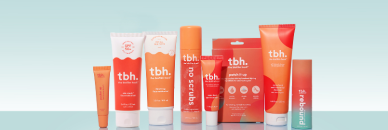Cleansing is probably the first thing you think of when it comes to skincare. Washing your face is an essential step in your daily routine and is the foundation of a good regime. Finding a cleanser that matches your skin type and then figuring out how to use a cleanser correctly is the first step to nailing your skincare routine.
Is cleanser necessary?
I feel like asking if a cleanser is necessary is like asking if coffee is necessary. The answer is yes, always. It would be like if you didn’t wash your hands all day. We of course need to be cleansing our face once or twice a day. Otherwise, we’d be leaving lingering bacteria and gunk on our skin - not what we want when trying to maintain happy, healthy skin.
What does a cleanser do?
Its main purpose is to wash away all the dirt that builds up on our skin's surface throughout the day that we don’t want to stay there when we go to bed. It melts away excess makeup, oil, bacteria and the buildup of dead skin cells. This in turn prevents clogged pores. Clogged pores and congestion is one of the key causes of breakouts, so it's easy to understand why you don't want to skin this step.

How often should you cleanse?
It is recommended to wash your face twice a day. Those with oily skin often feel more inclined to cleanse morning and night to remove excess oils from the skin. Whilst we would recommend cleansing twice a day, you do want to make sure you aren't stripping your skin too much of its natural oils. If you feel your skin is tight or dry, you may want to pull back to cleansing once a day in the evenings, and just using a splash of water to refresh yourself in the morning. It is worth noting that if you wish to cleanse only once daily, you absolutely must do this in the evenings. Cleansing at the end of the day makes sure you remove dirt, pollution, makeup, SPF and other build up from throughout the day.
How to apply cleanser
Step 1: Get your hair out of the way
I know you want to jump right in and start the process straight away but, you'll regret not tying your hair back when it's dripping wet and you need to pull your hair dryer out to dry off your hair, so take a second and grab a hair elastic or a headband and get your hair out of the way.
Step 2: Splash your face with some water
Starting with a wet face will make the process a whole lot smoother. Make sure your face is damp to begin with.
Step 3: Apply the cleanser to your face
Hopefully you’ve already found your go-to cleanser that's the right match for your skin type. If you haven't and find that you are prone to congestion and blackheads, the anti-bacterial cleanser may be the product you've been searching for! Or if you have sensitive skin, the gentle cleanser could be your match.
Squeeze about a 10c -20c piece amount into your hands and apply the cleanser directly to your skin, making sure to spread it evenly and get into all the hard-to-reach places. Make sure you are not forgetting to take extra care around those areas prone to congestion, most commonly found in the T-zone area. We recommend cleansing for no less than 30 seconds, so make sure you count bestie!
Step 4: Rinse
Take some lukewarm water and wash away the cleanser from your skin. It is super important to make sure that the water we are using is not super hot, as this can wreak havoc on your skin barrier. Be sure to remove all of the leftover cleanser as well, because if you have a residual product left over this can cause irritation to your skin.
Step 5: Double cleanse (optional)
It is a popular practice to double cleanse, meaning cleansing your face twice. This ensures that your skin is left extra squeaky clean. When double cleaning, it is suggested to alternate between two cleansers. For example, you could start with your antibacterial cleanser and then follow up with the gentle cleanser for your second step. Double cleansing is particularly important if you are relying on your cleansers alone to remove all of your makeup. If you’ve had a makeup-free day, one cleanse should be enough!
Step 6: Rise (again)
Remove the cleanser from your skin as mentioned in step 4. If you're washing your face over the bathroom basin, sometimes adding in a washcloth to this step can be a helpful way of making sure you remove all remaining product without flooding your bathroom floor 😂.
Step 7: Pat your face dry
Take a clean towel and pat your face dry in preparation for the rest of your products. Leaving your skin slightly damp can actually help to improve the absorption of your other products to follow!
Step 8: Apply the rest of your products
Now that your skin is nice and clean you are free to move on with the rest of your routine. Cleansing is the base of any great routine. After cleansing, you may wish to go in with your other daily staples: Rebound serum, Thirst trap moisturiser and Skin shady SPF50+ and you’ll be ready for the day!

How much cleanser should you use?
Less is not necessarily more when it comes to cleansing. Using an excessive amount of cleanser will most likely only result in wasting additional product rather than making your face cleaner. We all know your bank account isn't going to love you if you keep having to repurchase cleansers sooner than actually necessary! Using a 10c piece size is more than enough to cleanse your entire face well enough and leave your skin feeling nice and clean.
Does cleanser help acne?
As a cleanser's main job is to remove dirt and bacteria that clog our pores, cleansing definitely helps acne as build up and congestion in the skin is a well known cause of acne. Some cleansers also have acne-fighting ingredients in them that can help to treat bacteria behind your breakout's inflammation. The anti-bacterial cleanser is a great cleanser that fights breakout causing bacteria with patented technology. It removes the unwanted congestion from your skin without leaving it feeling dry like some other cleansers can. Plus, it's well suited for oily, breakout-prone skin - a win-win for our acne-prone besties. If you're experiencing breakouts you can pair the anti-bacterial cleanser with the acne hack cream and some pimple patches to get the best results!
Can cleanser remove makeup?
Cleansers are generally used to remove oil, dirt, bacteria and makeup residue, rather than take off a full application of makeup products. We would recommend using a specific makeup remover, like a micellar water or cleansing balm before going in with your regular daily cleanser to ensure you get the best results. Or, if you are wanting to use your cleanser as your makeup remover, just be sure to double cleanse as mentioned before!
Can you use facial cleanser on your body?
Definitely! Most facial cleansers will work just as well, if not better, on your body as traditional soap does! It is also well known that many of your supermarket body washes can strip your skin of its natural oils leaving it feeling dry.
If you're experiencing body acne specifically, the anti-bacterial cleanser is a GREAT product to start using on the body areas where you’re experiencing breakouts.












